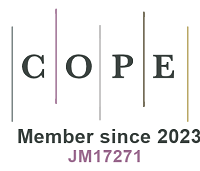REFERENCES
1. ATSDR. PFAS exposure assessments. Available from: https://www.atsdr.cdc.gov/pfas/activities/assessments.html. [Last accessed on 29 May 2024].
2. CDC. Fourth national report on human exposure to environmental chemicals, updated tables, March 2021: volume three: analysis of pooled serum samples for select chemicals, NHANES 2005-2016. Available from: https://stacks.cdc.gov/view/cdc/105344. [Last accessed on 29 May 2024].
3. Dunder L, Lind PM, Salihovic S, Stubleski J, Kärrman A, Lind L. Changes in plasma levels of per- and polyfluoroalkyl substances (PFAS) are associated with changes in plasma lipids - a longitudinal study over 10 years. Environ Res 2022;211:112903.
4. Li Y, Barregard L, Xu Y, et al. Associations between perfluoroalkyl substances and serum lipids in a Swedish adult population with contaminated drinking water. Environ Health 2020;19:33.
5. Lin PD, Cardenas A, Hauser R, et al. Per- and polyfluoroalkyl substances and blood lipid levels in pre-diabetic adults-longitudinal analysis of the diabetes prevention program outcomes study. Environ Int 2019;129:343-53.
6. Liu JJ, Cui XX, Tan YW, et al. Per- and perfluoroalkyl substances alternatives, mixtures and liver function in adults: a community-based population study in China. Environ Int 2022;163:107179.
7. Salihovic S, Stubleski J, Kärrman A, et al. Changes in markers of liver function in relation to changes in perfluoroalkyl substances - a longitudinal study. Environ Int 2018;117:196-203.
8. Averina M, Brox J, Huber S, Furberg AS. Exposure to perfluoroalkyl substances (PFAS) and dyslipidemia, hypertension and obesity in adolescents. the fit futures study. Environ Res 2021;195:110740.
9. Pitter G, Zare Jeddi M, Barbieri G, et al. Perfluoroalkyl substances are associated with elevated blood pressure and hypertension in highly exposed young adults. Environ Health 2020;19:102.
10. Bartell SM, Vieira VM. Critical review on PFOA, kidney cancer, and testicular cancer. J Air Waste Manag Assoc 2021;71:663-79.
11. Papadopoulou E, Sabaredzovic A, Namork E, Nygaard UC, Granum B, Haug LS. Exposure of Norwegian toddlers to perfluoroalkyl substances (PFAS): the association with breastfeeding and maternal PFAS concentrations. Environ Int 2016;94:687-94.
12. EFSA Panel on Contaminants in the Food Chain (EFSA CONTAM Panel); Schrenk D, Bignami M, Bodin L, et al. Risk to human health related to the presence of perfluoroalkyl substances in food. EFSA J 2020;18:e06223.
13. Schaider LA, Balan SA, Blum A, et al. Fluorinated compounds in U.S. fast food packaging. Environ Sci Technol Lett 2017;4:105-11.
14. Glenn G, Shogren R, Jin X, Orts W, Hart-Cooper W, Olson L. Per- and polyfluoroalkyl substances and their alternatives in paper food packaging. Compr Rev Food Sci Food Saf 2021;20:2596-625.
15. Curtzwiler GW, Silva P, Hall A, Ivey A, Vorst K. Significance of perfluoroalkyl substances (PFAS) in food packaging. Integr Environ Assess Manag 2021;17:7-12.
16. Seltenrich N. PFAS in food packaging: a hot, greasy exposure. Environ Health Perspect 2020;128:54002.
17. ATSDR. Toxicological profile for perfluoroalkyls. 2021. Available from: https://www.atsdr.cdc.gov/toxprofiles/tp200.pdf. [Last accessed on 29 May 2024].
18. Thépaut E, Dirven HAAM, Haug LS, et al. Per- and polyfluoroalkyl substances in serum and associations with food consumption and use of personal care products in the Norwegian biomonitoring study from the EU project EuroMix. Environ Res 2021;195:110795.
19. Trudel D, Horowitz L, Wormuth M, Scheringer M, Cousins IT, Hungerbühler K. Estimating consumer exposure to PFOS and PFOA. Risk Anal 2008;28:251-69.
20. Kato K, Wong LY, Chen A, et al. Changes in serum concentrations of maternal poly- and perfluoroalkyl substances over the course of pregnancy and predictors of exposure in a multiethnic cohort of Cincinnati, Ohio pregnant women during 2003-2006. Environ Sci Technol 2014;48:9600-8.
21. Park SK, Peng Q, Ding N, Mukherjee B, Harlow SD. Determinants of per- and polyfluoroalkyl substances (PFAS) in midlife women: evidence of racial/ethnic and geographic differences in PFAS exposure. Environ Res 2019;175:186-99.
22. Sagiv SK, Rifas-Shiman SL, Webster TF, et al. Sociodemographic and perinatal predictors of early pregnancy per- and polyfluoroalkyl substance (PFAS) concentrations. Environ Sci Technol 2015;49:11849-58.
23. McAdam J, Bell EM. Determinants of maternal and neonatal PFAS concentrations: a review. Environ Health 2023;22:41.
24. Nyström J, Benskin JP, Plassmann M, et al. Demographic, life-style and physiological determinants of serum per- and polyfluoroalkyl substance (PFAS) concentrations in a national cross-sectional survey of Swedish adolescents. Environ Res 2022;208:112674.
25. Bartolomé M, Gallego-Picó A, Cutanda F, et al; Bioambient.es. Perfluorinated alkyl substances in Spanish adults: geographical distribution and determinants of exposure. Sci Total Environ 2017;603-4:352-60.
26. Barton KE, Starling AP, Higgins CP, McDonough CA, Calafat AM, Adgate JL. Sociodemographic and behavioral determinants of serum concentrations of per- and polyfluoroalkyl substances in a community highly exposed to aqueous film-forming foam contaminants in drinking water. Int J Hyg Environ Health 2020;223:256-66.
27. Richterová D, Govarts E, Fábelová L, et al. PFAS levels and determinants of variability in exposure in European teenagers - Results from the HBM4EU aligned studies (2014-2021). Int J Hyg Environ Health 2023;247:114057.
28. Pitter G, Da Re F, Canova C, et al. Serum levels of perfluoroalkyl substances (PFAS) in adolescents and young adults exposed to contaminated drinking water in the Veneto Region, Italy: a cross-sectional study based on a health surveillance program. Environ Health Perspect 2020;128:27007.
29. Li Y, Andersson A, Xu Y, et al. Determinants of serum half-lives for linear and branched perfluoroalkyl substances after long-term high exposure - a study in Ronneby, Sweden. Environ Int 2022;163:107198.
30. Cuffney M, Wilkie AA, Kotlarz N, et al. Factors associated with per- and polyfluoroalkyl substances (PFAS) serum concentrations in residents of New Hanover County, North Carolina: the GenX exposure study. Environ Res 2023;237:117020.
31. Fábelová L, Beneito A, Casas M, et al. PFAS levels and exposure determinants in sensitive population groups. Chemosphere 2023;313:137530.
32. Tsai MS, Miyashita C, Araki A, et al. Determinants and temporal trends of perfluoroalkyl substances in pregnant women: the Hokkaido study on environment and children’s health. Int J Environ Res Public Health 2018;15:989.
33. Tian Y, Zhou Y, Miao M, et al. Determinants of plasma concentrations of perfluoroalkyl and polyfluoroalkyl substances in pregnant women from a birth cohort in Shanghai, China. Environ Int 2018;119:165-73.
34. Huo X, Liang W, Tang W, et al; Shanghai Birth Cohort Study. Dietary and maternal sociodemographic determinants of perfluoroalkyl and polyfluoroalkyl substance levels in pregnant women. Chemosphere 2023;332:138863.
35. Mahfouz M, Harmouche-Karaki M, Matta J, et al. Maternal serum, cord and human milk levels of per- and polyfluoroalkyl substances (PFAS), association with predictors and effect on newborn anthropometry. Toxics 2023;11:455.
36. Sørensen MM, Fisker AB, Dalgård C, et al. Predictors of serum- per- and polyfluoroalkyl substance (PFAS) concentrations among infants in Guinea-Bissau, West Africa. Environ Res 2023;228:115784.
37. Manzano-Salgado CB, Casas M, Lopez-Espinosa MJ, et al. Variability of perfluoroalkyl substance concentrations in pregnant women by socio-demographic and dietary factors in a Spanish birth cohort. Environ Int 2016;92-3:357-65.
38. Jain RB, Ducatman A. Factors affecting serum PFAS concentrations among US females with surgically and naturally induced menopause: data from NHANES 2003-2018. Environ Sci Pollut Res Int 2023;30:84705-24.
39. Obeng-Gyasi E. Factors associated with elevated per- and polyfluoroalkyl substances serum levels in older adults. Aging Health Res 2022;2:100086.
40. Graber JM, Black TM, Shah NN, et al. Prevalence and predictors of per- and polyfluoroalkyl substances (PFAS) serum levels among members of a suburban US volunteer fire department. Int J Environ Res Public Health 2021;18:3730.
41. Chiu WA, Lynch MT, Lay CR, et al. Bayesian estimation of human population toxicokinetics of PFOA, PFOS, PFHxS, and PFNA from studies of contaminated drinking water. Environ Health Perspect 2022;130:127001.
42. Seshasayee SM, Rifas-Shiman SL, Chavarro JE, et al. Dietary patterns and PFAS plasma concentrations in childhood: project Viva, USA. Environ Int 2021;151:106415.
43. CDC. National health and nutrition examination survey: analytic guidelines, 1999-2010. Available from: https://www.cdc.gov/nchs/data/series/sr_02/sr02_161.pdf. [Last accessed on 29 May 2024].
44. Calafat AM, Wong LY, Kuklenyik Z, Reidy JA, Needham LL. Polyfluoroalkyl chemicals in the U.S. population: data from the National Health and Nutrition Examination Survey (NHANES) 2003-2004 and comparisons with NHANES 1999-2000. Environ Health Perspect 2007;115:1596-602.
45. Kato K, Wong LY, Jia LT, Kuklenyik Z, Calafat AM. Trends in exposure to polyfluoroalkyl chemicals in the U.S. population: 1999-2008. Environ Sci Technol 2011;45:8037-45.
46. Hornung RW, Reed LD. Estimation of average concentration in the presence of nondetectable values. Appl Occup Environ Hyg 1990;5:46-51.
47. National Academies of Sciences, Engineering, and Medicine; Health and Medicine Division; Division on Earth and Life Studies; Board on Population Health and Public Health Practice; Board on Environmental Studies and Toxicology; Committee on the Guidance on PFAS Testing and Health Outcomes. Guidance on PFAS exposure, testing, and clinical follow-up. 2022.
48. Analytic and reporting guidelines: the national health and nutrition examination survey (NHANES). 2005. Available from: https://wwwn.cdc.gov/nchs/data/nhanes/analyticguidelines/05-06-analytic-guidelines.pdf. [Last accessed on 29 May 2024].
49. Zhao Y, Jin H, Qu J, et al. The influences of perfluoroalkyl substances on the rheumatoid arthritis clinic. BMC Immunol 2022;23:10.
50. von Holst H, Nayak P, Dembek Z, et al. Perfluoroalkyl substances exposure and immunity, allergic response, infection, and asthma in children: review of epidemiologic studies. Heliyon 2021;7:e08160.
51. Stanifer JW, Stapleton HM, Souma T, Wittmer A, Zhao X, Boulware LE. Perfluorinated chemicals as emerging environmental threats to kidney health: a scoping review. Clin J Am Soc Nephrol 2018;13:1479-92.
52. Meneguzzi A, Fava C, Castelli M, Minuz P. Exposure to perfluoroalkyl chemicals and cardiovascular disease: experimental and epidemiological evidence. Front Endocrinol 2021;12:706352.
53. Kim MJ, Moon S, Oh BC, et al. Association between perfluoroalkyl substances exposure and thyroid function in adults: a meta-analysis. PLoS One 2018;13:e0197244.
54. Gui SY, Qiao JC, Xu KX, et al. Association between per- and polyfluoroalkyl substances exposure and risk of diabetes: a systematic review and meta-analysis. J Expo Sci Environ Epidemiol 2023;33:40-55.
55. Fenton SE, Ducatman A, Boobis A, et al. Per- and polyfluoroalkyl substance toxicity and human health review: current state of knowledge and strategies for informing future research. Environ Toxicol Chem 2021;40:606-30.
56. Kuhn M, Johnson K. Handling missing data. In: Feature engineering and selection: a practical approach for predictive models. Chapman and Hall; 2019.
57. Emmanuel T, Maupong T, Mpoeleng D, Semong T, Mphago B, Tabona O. A survey on missing data in machine learning. J Big Data 2021;8:140.
58. HotDeckImputation-package: hot deck imputation methods for missing data. Available from: https://www.rdocumentation.org/packages/HotDeckImputation/versions/1.1.0/topics/HotDeckImputation-package. [Last accessed on 29 May 2024].
59. Andridge RR, Little RJ. A review of hot deck imputation for survey non-response. Int Stat Rev 2010;78:40-64.
61. van Buuren S, Groothuis-Oudshoorn K. mice: multivariate imputation by chained equations in R. J Stat Soft 2011;45:1-67.
62. Zou H, Hastie T. Regularization and variable selection via the elastic net. J R Stat Soc B 2005;67:301-20.
63. USEPA. EPA and 3M announce phase out of pfos. 2000. Available from: https://www.epa.gov/archive/epapages/newsroom_archive/newsreleases/33aa946e6cb11f35852568e1005246b4.html. [Last accessed on 29 May 2024].
64. USEPA. PFOA stewardship program baseline year summary report. Available from: https://www.epa.gov/assessing-and-managing-chemicals-under-tsca/pfoa-stewardship-program-baseline-year-summary-report. [Last accessed on 29 May 2024].
65. Toms LM, Thompson J, Rotander A, et al. Decline in perfluorooctane sulfonate and perfluorooctanoate serum concentrations in an Australian population from 2002 to 2011. Environ Int 2014;71:74-80.
66. Hurley S, Goldberg D, Wang M, et al. Time trends in per- and polyfluoroalkyl substances (PFASs) in California women: declining serum levels, 2011-2015. Environ Sci Technol 2018;52:277-87.
67. Salvalaglio M, Muscionico I, Cavallotti C. Determination of energies and sites of binding of PFOA and PFOS to human serum albumin. J Phys Chem B 2010;114:14860-74.
68. Weaving G, Batstone GF, Jones RG. Age and sex variation in serum albumin concentration: an observational study. Ann Clin Biochem 2016;53:106-11.
69. Denic A, Glassock RJ, Rule AD. Structural and functional changes with the aging kidney. Adv Chronic Kidney Dis 2016;23:19-28.
70. Milanović Z, Pantelić S, Trajković N, Sporiš G, Kostić R, James N. Age-related decrease in physical activity and functional fitness among elderly men and women. Clin Interv Aging 2013;8:549-56.
71. Musso CG, Oreopoulos DG. Aging and physiological changes of the kidneys including changes in glomerular filtration rate. Nephron Physiol 2011;119 Suppl 1:p1-5.
72. Verner MA, Loccisano AE, Morken NH, et al. Associations of perfluoroalkyl substances (PFAS) with lower birth weight: an evaluation of potential confounding by glomerular filtration rate using a physiologically based pharmacokinetic model (PBPK). Environ Health Perspect 2015;123:1317-24.
73. Rickard BP, Rizvi I, Fenton SE. Per- and poly-fluoroalkyl substances (PFAS) and female reproductive outcomes: PFAS elimination, endocrine-mediated effects, and disease. Toxicology 2022;465:153031.
74. Salihovic S, Kärrman A, Lind L, Lind PM, Lindström G, van Bavel B. Perfluoroalkyl substances (PFAS) including structural PFOS isomers in plasma from elderly men and women from Sweden: results from the prospective investigation of the vasculature in Uppsala seniors (PIVUS). Environ Int 2015;82:21-7.
75. Muennig P, Song X, Payne-Sturges DC, Gee GC. Blood and urine levels of long half-life toxicants by nativity among immigrants to the United States. Sci Total Environ 2011;412-3:109-13.
76. Fiedler H, Sadia M. Regional occurrence of perfluoroalkane substances in human milk for the global monitoring plan under the Stockholm Convention on Persistent Organic Pollutants during 2016-2019. Chemosphere 2021;277:130287.
77. Rahman MA. Household characteristics and poverty: a logistic regression analysis. J Develop Areas 2013;47:303-17. Available from: http://www.jstor.org/stable/23612271. [Last accessed on 29 May 2024]
78. Cariou R, Veyrand B, Yamada A, et al. Perfluoroalkyl acid (PFAA) levels and profiles in breast milk, maternal and cord serum of French women and their newborns. Environ Int 2015;84:71-81.
79. Lorber M, Eaglesham GE, Hobson P, Toms LM, Mueller JF, Thompson JS. The effect of ongoing blood loss on human serum concentrations of perfluorinated acids. Chemosphere 2015;118:170-7.
80. Manzano-Salgado CB, Casas M, Lopez-Espinosa MJ, et al. Transfer of perfluoroalkyl substances from mother to fetus in a Spanish birth cohort. Environ Res 2015;142:471-8.
81. Mondal D, Weldon RH, Armstrong BG, et al. Breastfeeding: a potential excretion route for mothers and implications for infant exposure to perfluoroalkyl acids. Environ Health Perspect 2014;122:187-92.
82. Fromme H, Tittlemier SA, Völkel W, Wilhelm M, Twardella D. Perfluorinated compounds - exposure assessment for the general population in Western countries. Int J Hyg Environ Health 2009;212:239-70.
83. Li Y, Fletcher T, Mucs D, et al. Half-lives of PFOS, PFHxS and PFOA after end of exposure to contaminated drinking water. Occup Environ Med 2018;75:46-51.
84. CDC. Fourth national report on human exposure to environmental chemicals: updated tables, January 2019, volume one. 2019.
85. Jain RB. Contribution of diet and other factors to the levels of selected polyfluorinated compounds: data from NHANES 2003-2008. Int J Hyg Environ Health 2014;217:52-61.
86. Nelson JW, Scammell MK, Hatch EE, Webster TF. Social disparities in exposures to bisphenol A and polyfluoroalkyl chemicals: a cross-sectional study within NHANES 2003-2006. Environ Health 2012;11:10.
87. Liddie JM, Schaider LA, Sunderland EM. Sociodemographic factors are associated with the abundance of PFAS sources and detection in U.S. community water systems. Environ Sci Technol 2023;57:7902-12.
88. Vieux F, Maillot M, Rehm CD, Barrios P, Drewnowski A. Trends in tap and bottled water consumption among children and adults in the United States: analyses of NHANES 2011-16 data. Nutr J 2020;19:10.
89. Gorelick MH, Gould L, Nimmer M, et al. Perceptions about water and increased use of bottled water in minority children. Arch Pediatr Adolesc Med 2011;165:928-32.
90. Rosinger AY, Herrick KA, Wutich AY, Yoder JS, Ogden CL. Disparities in plain, tap and bottled water consumption among US adults: national health and nutrition examination survey (NHANES) 2007-2014. Public Health Nutr 2018;21:1455-64.
91. Park S, Onufrak S, Patel A, Sharkey JR, Blanck HM. Perceptions of drinking water safety and their associations with plain water intake among US Hispanic adults. J Water Health 2019;17:587-96.
92. Consumer Reports. What’s really in your bottled water? 2020. Available from: https://www.consumerreports.org/water-quality/whats-really-in-your-bottled-water-a5361150329/. [Last accessed on 29 May 2024].
93. Chow SJ, Ojeda N, Jacangelo JG, Schwab KJ. Detection of ultrashort-chain and other per- and polyfluoroalkyl substances (PFAS) in U.S. bottled water. Water Res 2021;201:117292.
94. Krachler M, Shotyk W. Trace and ultratrace metals in bottled waters: survey of sources worldwide and comparison with refillable metal bottles. Sci Total Environ 2009;407:1089-96.
95. Stoiber T, Evans S, Temkin AM, Andrews DQ, Naidenko OV. PFAS in drinking water: an emergent water quality threat. 2020. Available from: https://www.ewg.org/sites/default/files/u352/Stoiber_Evans_WaterSolutions_2020.pdf. [Last accessed on 29 May 2024].
96. Augustsson A, Lennqvist T, Osbeck CMG, et al. Consumption of freshwater fish: a variable but significant risk factor for PFOS exposure. Environ Res 2021;192:110284.
97. Barbo N, Stoiber T, Naidenko OV, Andrews DQ. Locally caught freshwater fish across the United States are likely a significant source of exposure to PFOS and other perfluorinated compounds. Environ Res 2023;220:115165.
98. von Stackelberg K, Li M, Sunderland E. Results of a national survey of high-frequency fish consumers in the United States. Environ Res 2017;158:126-36.
99. Wattigney WA, Savadatti SS, Liu M, et al. Biomonitoring of per- and polyfluoroalkyl substances in minority angler communities in central New York State. Environ Res 2022;204:112309.
100. Christensen KY, Raymond M, Blackowicz M, et al. Perfluoroalkyl substances and fish consumption. Environ Res 2017;154:145-51.
101. Haug LS, Thomsen C, Brantsaeter AL, et al. Diet and particularly seafood are major sources of perfluorinated compounds in humans. Environ Int 2010;36:772-8.
102. Lee JH, Lee CK, Suh CH, Kang HS, Hong CP, Choi SN. Serum concentrations of per- and poly-fluoroalkyl substances and factors associated with exposure in the general adult population in South Korea. Int J Hyg Environ Health 2017;220:1046-54.
103. Lindh CH, Rylander L, Toft G, et al. Blood serum concentrations of perfluorinated compounds in men from Greenlandic Inuit and European populations. Chemosphere 2012;88:1269-75.
104. Liu Y, Su J, van Dam RM, et al. Dietary predictors and plasma concentrations of perfluorinated alkyl acids in a Singapore population. Chemosphere 2017;171:617-24.
105. Yamaguchi M, Arisawa K, Uemura H, et al. Consumption of seafood, serum liver enzymes, and blood levels of PFOS and PFOA in the Japanese population. J Occup Health 2013;55:184-94.
106. Beesoon S, Genuis SJ, Benskin JP, Martin JW. Exceptionally high serum concentrations of perfluorohexanesulfonate in a Canadian family are linked to home carpet treatment applications. Environ Sci Technol 2012;46:12960-7.
107. Martin JW, Asher BJ, Beesoon S, Benskin JP, Ross MS. PFOS or PreFOS? Are perfluorooctane sulfonate precursors (PreFOS) important determinants of human and environmental perfluorooctane sulfonate (PFOS) exposure? J Environ Monit 2010;12:1979-2004.
108. Strynar MJ, Lindstrom AB. Perfluorinated compounds in house dust from Ohio and North Carolina, USA. Environ Sci Technol 2008;42:3751-6.
109. Jian JM, Chen D, Han FJ, et al. A short review on human exposure to and tissue distribution of per- and polyfluoroalkyl substances (PFASs). Sci Total Environ 2018;636:1058-69.
110. Cuffney M, Wilkie A, Kotlarz N, et al. Factors associated with per-and polyfluoroalkyl substances (PFAS) serum concentrations in residents of Wilmington, North Carolina: the genx exposure study. SSRN 2023.
111. Colles A, Bruckers L, Den Hond E, et al. Perfluorinated substances in the Flemish population (Belgium): levels and determinants of variability in exposure. Chemosphere 2020;242:125250.
112. Raudhatunnisa T, Wilantika N. Performance comparison of hot-deck imputation, K-nearest neighbor imputation, and predictive mean matching in missing value handling, case study: March 2019 SUSENAS Kor dataset. icdsos 2022;2021:753-70.







